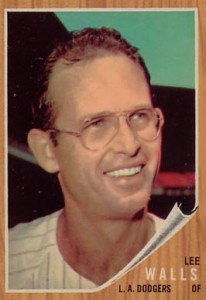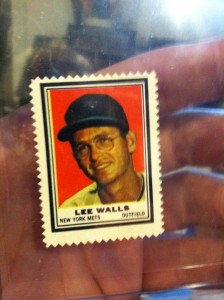The Holy Books have their share of oddities, from Lost Mets to weirdo minor league cards to guys with one career at-bat. But the oddest card of all comes in the section reserved for the 1961 Expansion Draft. That section includes the 22 players chosen by the Mets to stock their inaugural roster from the collection of has-beens and never-weres made available by the other clubs. (Confronting the motley goods available to him and Mets GM George Weiss, Colt .45s GM Paul Richards announced, “Gentlemen, we’re fucked.”)
The first player in the THB Expansion Draft lineup is Hobie Landrith, the ur-Met. So it runs from there — immortal names such as Elio Chacon, Ed Bouchee, Choo Choo Coleman, Sherman “Roadblock” Jones, Jay Hook — until you get to the 22nd and final player, Lee Walls.
Who?
Ray Lee Walls, of course.
Lee Walls was indeed a Met in October 1961. But he wasn’t one by April 1962: In December Weiss traded him, along with $100,000 of the Mets’ money, to the Dodgers for Charley Neal and Willard Hunter. Walls, by the way, had cost the Mets $125,000 to select, so it cost the Mets $225,000 in 1962 dollars (about $1.7 million today) to watch Charley Neal hit 11 home runs and boot several zillion balls.
In THB terms, Walls’s legacy is a 1961 Topps card in which he’s wearing a Phillies uniform and his trademark spectacles — the only player enshrined in The Holy Books who never played for the Mets. It’s an interesting distinction, but I wondered what other Mets traces Walls might have left. And I wondered about him.
First up, his cardboard legacy.
 Walls wound up with two 1962 Dodgers cards — one in which he’s looking to his left and a variant in which he’s looking to his right. He’s hatless in both — standard Topps procedure as insurance against players changing teams. (This was also the era of horrific repaints of hats and uniforms by Topps to transfer late acquisitions into new uniforms, with little regard for players in the background — or sometimes the laws of physics.) The shot of Walls looking to his left has him in pinstripes that look a lot to me like Phillies’ pinstripes tinted gray. This, probably, was going to be Lee Walls’s 1962 Mets card, then replaced by a pinstripe-less shot. (I’m not going to swear on it — ’62 Topps is full of odd variations in photos, tint, etc.)
Walls wound up with two 1962 Dodgers cards — one in which he’s looking to his left and a variant in which he’s looking to his right. He’s hatless in both — standard Topps procedure as insurance against players changing teams. (This was also the era of horrific repaints of hats and uniforms by Topps to transfer late acquisitions into new uniforms, with little regard for players in the background — or sometimes the laws of physics.) The shot of Walls looking to his left has him in pinstripes that look a lot to me like Phillies’ pinstripes tinted gray. This, probably, was going to be Lee Walls’s 1962 Mets card, then replaced by a pinstripe-less shot. (I’m not going to swear on it — ’62 Topps is full of odd variations in photos, tint, etc.)
But Walls did make the Mets in one Topps line — Topps Stamps. He’s No. 140, right between Bob L. Miller and Don Zimmer (who appears in a Mets hat on his ’62 Cincinnati Reds card, but that’s another story). I’d never heard of Topps Stamps, but I couldn’t resist the pull of Lee Walls identified as a New York Met. When the stamp came around on eBay, I bid on it, steeled myself not to go too crazy over a niche product featuring a guy who’d never actually worn orange and blue — and won it for the grand total of 99 cents.
Perfect condition, too.
So much for Lee Walls and Topps. But what about the man himself?
Lee Walls’s trade to the Dodgers was a blessing for him — he was a California kid, a renowned schoolboy athlete who’d thrown four no-hitters at Pasadena High. That was enough for Branch Rickey to give him a $12,000 bonus and a contract with the Pirates in 1951. Rickey saw Walls could pitch, but he also saw that he could hit, and a few spring-training home runs led the Mahatma to turn his new acquisition into an outfielder. Walls hit .342 for Modesto in 1951, then .308 for Waco the next year, which earned him a call-up to the Pirates as a 19-year-old. He hit .188 and wouldn’t be seen in the big leagues again until 1956.
Walls spent three years playing for the Hollywood Stars of the Pacific Coast League. With the Dodgers and Giants still in New York, that was by no means a bad life — and Walls seems to have a ball supplementing it. He played gunfighters in Westerns and was a maitre d’ in a Palm Springs restaurant, where one day Miss Palm Springs and some friends came in to sell buttons promoting a rodeo. Walls parlayed the button into a date, and the date into a marriage. (Later teammates remarked that Walls had a gift of gab and loved charming his way into fancy restaurants where he and his companions had to stick to the cheap end of the menu.)
The Pirates brought Walls back to the big leagues in 1957, but soon traded him to the Cubs. In 1958, he’d become a folk hero — and a bit player in a baseball drama. The relocated Dodgers were playing in the Los Angeles Coliseum, where the left-field foul pole was just 257 feet away — an arrangement that prompted dire warnings that baseball’s home-run records would be besieged.
Those warnings seemed prescient on April 24, in the Dodgers’ fifth home game. In the first inning, Walls hit a two-run homer off Don Drysdale. In the fifth, he hit a three-run shot off Roger Craig. In the seventh, he hit another three-run homer off Ron Negray. Scribes howled, but Walls defended himself: All three homers had gone over the fence by a comfortable margin (just ask Walter Alston, he insisted), and he’d spent the off-season lifting weights to strengthen his wrists and forearms — heretical advice at the time, but touted by no less than Ted Williams.
Walls continued his home run barrage and became an All-Star during his finest season: a .304 average, 24 homers and 72 RBI. His unlikely heroics and horn-rimmed dark glasses earned him a pretty fantastic nickname from Cubs fans — “Captain Midnight.” His few months as a slugger would also intrigue a Kansas kid who wondered about ballplayers’ brief streaks of stardom, their explanations for such sudden success, and whether those explanations were sound or Just So Stories about statistical noise. That kid was named Bill James, destined to revolutionize the game.
Walls was never that good again, but memories of his 1958 campaign kept him afloat as a useful journeyman, one who could play any outfield position competently, and not embarrass himself as a corner infielder. He could pinch-hit — in ’62, he collected 13 hits in 27 at-bats for L.A. — and newspaper accounts from the early 60s hint that he’d become a wise old hand, respected by Alston and a reliable quote for reporters. But for all that, he was done in 1964, at 31. He played for the Hankyu Braves in 1965 (they’re now the Orix Buffaloes), but would never return to the majors. At least not as a player — he did make it back as a coach, one of Billy Martin’s confidantes with the A’s and then the Yankees, where he earned the derisive nickname “Echo” for supposedly repeating whatever Martin said.
Walls died in 1993. He was only 60. No, he was never a Met. But he lived a pretty interesting baseball life nonetheless.








Jason, you wrote of Lee Walls: “…the only player enshrined in The Holy Books who never played for the Mets.”
Hmmm. Although young OF Brian Cole never played for the parent NY Mets due to very tragic circumstances, I believe he did appear on a 2001 Topps multi-player rookie card in a Met uniform (if memory serves me correctly). I’ll have to run to my basement to check my own version of THB.
Thus, wouldn’t Cole be the second player in your authoritative, unabridged THB who can be categorized the same way as Lee Walls?
Hi Jason,
So glad you showed that stamp – not many realize that Topps also had a stamp book in 1962 which kids could buy separately and fill it up with two stamps included in each pack along with five cards and a stick of gum. For quite a while I was buying the packs more for the stamps than the cards.
I’m not quite sure but believe there were two pages for each team – but do remember the first stamp was for the team logo. Seeing them in color in the era of black and white was something for a ten year old to behold.
Let us share your Topps’ stamp collection if you have one. Those are great memories.
Joe
Since I only found your blog a few years ago, I missed the origins of THB, so I’m not sure of the ground rules, i.e. who’s eligible and who’s not.
Reason wny, after reading the above post I just had a memory flashback on a name from Spring training 1962: pitcher Evans Killeen. I can’t find any box scores from then, but he was from Brooklyn us local kids were aware of him being on the team. I actually recall he was unscored on for something like 6 innings in Spring training, but wound up not making the team on Opening Day.
I dan’t recall if he was on the actual Met Roster at the time or a Spring Invitee (did they even have that then??).
In any event his only MLB experience was 4 games with KC in 1959.
Not sure if a Spring Training Met goes into the book or not, but a seach of your blog doesn’t turn up any hits on the name. So maybe he’s a Totally Lost Met.
[…] if we can allow ourselves a slightly more generous definition in the spirit of Lee Walls, so is pitcher Evans Killeen, who (as Nick Diunte lets us know here) was one ornery shaving kit […]
Thanks for excellent bio on almost-a-Met Lee Walls. It is the 50th anniversary of Mets first year, opening of Dodger Stadium, and perhaps the greatest year a pinch hitter ever had. Walt Alston seemed to always send Lee up in a make-or-break pinch hitting situation and he’d come through, as his nearly .500 average attests. (It seems like after a couple of game-winners he’d get a start, go 0-4, and be back on the bench to save the day again. With record attendence in a new park and behind amazing years of Drysdale, Koufax, Willis and Tommy David the Dodgers won over 100 games but suffered a final week collapse as they fell into a tie and 3 game playoff with the Giants. It all looked over down by a game and trailing late in Game 2. Lee capped his great year with a pinch bases-loaded double to lead the comeback. Sadly, Giants rallied in the 9th of Game 3 with pinchitter Walls making the final out on a liner to Mays. Happy to say Lee was part of the ’63 World Champions team. His #7 is clearly seen in most celebration photos although he didn’t get into a series game. Lee’s final game in ’64 saw him go behind the plate for the only time, something he had taught himself to increase his value as a utility player.
That’s awesome — thanks Bruce!